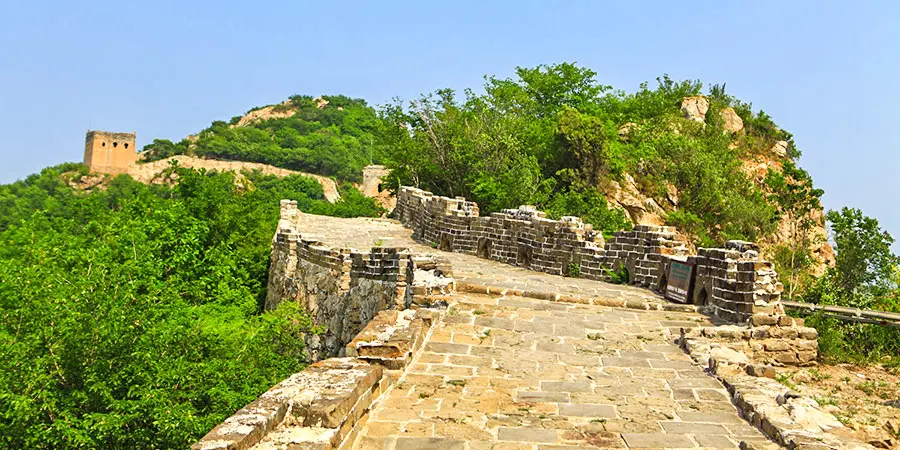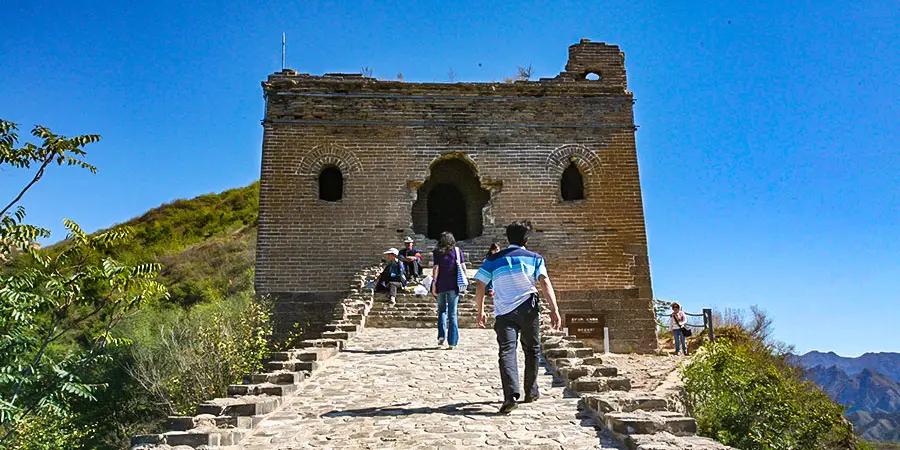The Badaling Remnant Great Wall is located 5 kilometers (3 miles) southwest of the Badaling Great Wall in Yanqing County, Beijing. It is also known as the Shixiaguan Great Wall, and functions as the west gate of the defense system of the Badaling Great Wall. With a total length of 2 kilometers (1.2 miles), the V-shaped wall is comprised of two sections, with a breach in the middle, and four beacon towers. Despite its partial ruin, the wall's magnificent scale remains discernible. Here, not only does the fragmented beauty of the ancient Great Wall prevail, but also the natural landscape presents an alluring charm. Notably, in spring, the Apricot Blossom Valley comes alive with a sea of pink apricot blossoms that blanket the mountains, creating a romantic and spectacular vista.
Best Attractions to Visit on the Badaling Remnant Great Wall
1. The original and unspoiled Great Wall
Ascending the mountain tops, you will see the broken, but time-honored wall crawling on the ridges, and the old beacon towers standing there quietly, like old wrinkled men. Some bricks are so seriously weathered that some pieces would collapse if you touch them. Some stone steps have become piles of stones due to disrepair. The wall is leaning and collapsing, while the beacon tower has severe cracks. Compared with the well-renovated section at Badaling, one can feel a stronger sense of historical changes here.
 |
| Badaling Remnant Great Wall |
2. Ancient Brick Kiln Complex
The ancient brick kilns were facilities used to bake bricks needed for building the Great Wall. Building the Great Wall required a large number of bricks, but transporting them from other places to the top of the mountain was very time-consuming and labor-intensive. The discovery of these brick kilns answered people's doubts, as the bricks were not transported from far away, but were made locally and baked on site, which stands as a testament to the remarkable wisdom of the ancient Chinese people.
The foundations of the wall were made from processed granite. Thus demand for the granite was rather huge during the construction. Finished and half-finished granite was found in the stone quarry. Additionally, the gunpowder plates found in the stone quarry indicated that gunpowder was used to level off hilltops. Thus, the mystery of how ancient people collected and transported granite when the productive forces were primitive was finally unveiled.
4. Apricot Blossom Valley
 |
| Badaling Remnant Great Wall |
Surrounding the Badaling Remnant Great Wall lies the Apricot Blossom Valley, which encompasses over a hundred acres of apricot trees. From the beginning to the end of April, the apricot blossoms burst into a glorious bloom, painting the entire area in a delicate palette of pink and white, transforming it into a veritable sea of blossoms.
Situated 200 meters (220 yards) north of the Badaling Remnant Great Wall lies the Stone Buddha Cave. Its entrance measures 2 meters (6.6 feet) in height and 4.7 meters (15.4 feet) in width. Within the cave stands a seated stone Buddha, reaching a height of 2.85 meters (9.34 feet). The carving of this Buddha is exquisitely detailed, its form is robust and its style is distinctive. It ranks among the scarce and well-preserved stone Buddha statues in Beijing.
The Badaling Remnant Great Wall Marked a Historic Turning Point
The wall is closely associated with a peasant uprising led by Li Zicheng (1606 - 1645), the leader of the peasant uprising army in the late
Ming Dynasty (1368-1644). He established his regime “Dashun” in Xi'an in 1644. Later, the leader marched his troops eastward to Beijing, but was stopped by the Badaling Great Wall. It was very difficult to break through. Finally, a local elder advised him to attack the Shixiaguan Great Wall which was lower. Li Zicheng took his advice and won the battle. As a result, Li and his troops occupied Beijing and overthrew the Ming Dynasty.
When is the best time to visit the Badaling Remnant Great Wall?
The best time to view the Badaling Remnant Great Wall is April, May, September, and October. During these periods, the temperature is idyllic, steering clear of extreme heat or cold, and the concomitant natural scenery is at its zenith. In April and May, the apricot blossoms carpet the area in a profusion of blooms, while September and October usher in a riot of crimson foliage, enhancing the allure of this majestic wonder.
How to tour the Badaling Remnant Great Wall?
Begin your journey by walking 1.5 kilometers (0.9 miles) from the scenic area's entrance to the foot of the Remnant Great Wall. On the way, you'll pass by the Ancient Brick Kiln Complex, Apricot Blossom Valley, and Quarry Ruins. Once you reach the Great Wall, start climbing on its right-hand side. This stretch of the Great Wall features four watchtowers. The terrain from the 1st to the 3rd watchtower is relatively flat, but it gets extremely steep from the 3rd to the 4th watchtower. After reaching the 4th watchtower, retrace your steps. The Great Wall stretches 2 kilometers (2 miles) long. The entire visit, including the round-trip, usually takes about 3 to 4 hours. For tourists with limited physical strength, it's advisable to turn back whenever you feel fatigued.
 |
| Hiking on the Badaling Remnant Great Wall |
How to Get the Badaling Remnant Great Wall from Beijing?

By bus:
Take bus No. 919 from
Deshengmen Bus Station to Badaling Remnant Great Wall Station, then walk about 1.2 kilometers (0.75 miles) southwest to arrive. Ticket fare is CNY 14 and the trip takes as long as 2 hours. Bus 919 has many branch lines and some of them do not go to the site; you’d better confirm with the driver before boarding.

By high-speed train:
Take the high-speed train from
Beijing North Railway Station or
Qinghe Railway Station to
Badaling Great Wall Railway Station. After exiting the station, walk about 200 meters (220 yards) and take the free shuttle bus near the entrance of the North Cableway Station to Badaling Wildlife Park bus stop (it is more convenient to take a taxi here), then take a taxi to Badaling Remnant Great Wall. The whole journey takes about 1.5 hours. This is the fastest way, but you need to transfer several times.
| Opening Hours | April to October: 9:00-17:00
November to March: 9:00-16:00 |
| Ticket Price | CNY 54
Free for children under 1.2m (3.9ft) |
| Recommended Tour Time | 3 - 4 hours |
Tips for Visiting the Badaling Remnant Great Wall
1. The steps of the Badaling Remnant Great Wall are extremely steep, where certain steps are so narrow that only half of a foot can be placed on them. Be sure to pay attention to safety during the climb.
2. There is no shops in the scenic area. Therefore, it is recommended to prepare food and water in advance to meet your needs during the tour.
- Last updated on Jan. 22, 2025 by Sherry Xia -


